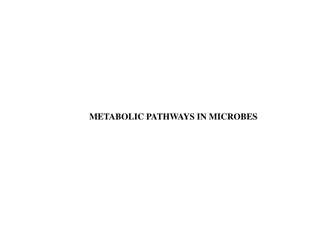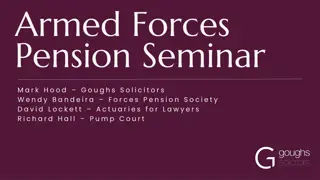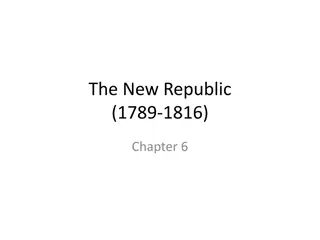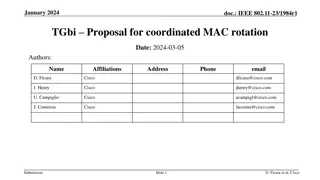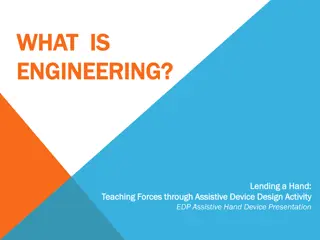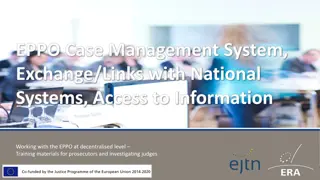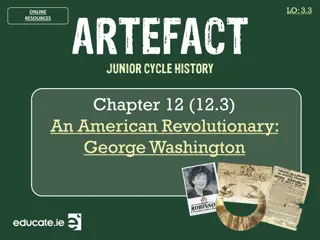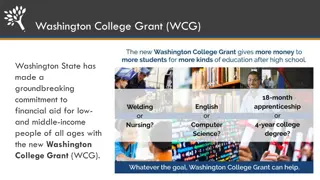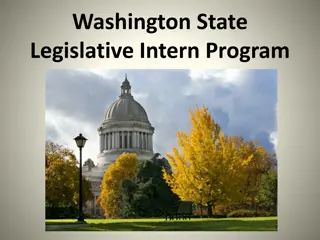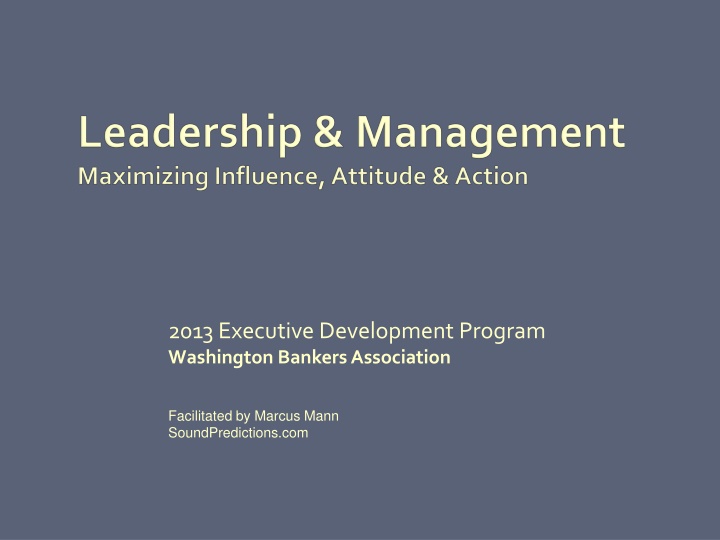
Leadership Development and Influence Techniques for Banking Professionals
Enhance your leadership skills and influence techniques in the banking sector with a focus on coaching, problem-solving, and fostering a culture of influence at every organizational level. Discover the power of open forum participation, examine myths hindering influence, and learn how to lead effectively through attitude and influence.
Download Presentation

Please find below an Image/Link to download the presentation.
The content on the website is provided AS IS for your information and personal use only. It may not be sold, licensed, or shared on other websites without obtaining consent from the author. If you encounter any issues during the download, it is possible that the publisher has removed the file from their server.
You are allowed to download the files provided on this website for personal or commercial use, subject to the condition that they are used lawfully. All files are the property of their respective owners.
The content on the website is provided AS IS for your information and personal use only. It may not be sold, licensed, or shared on other websites without obtaining consent from the author.
E N D
Presentation Transcript
2013 Executive Development Program Washington Bankers Association Facilitated by Marcus Mann SoundPredictions.com
About you (below) About me About our day Group exercise: Why do you wish to lead others? How do you lead? How do you measure your effectiveness?
Facilitative / Open / Guided Forum Participation -No Lecture Most Effective: Open & Honest Specific Examples Work Best Express Opinions Own Them with Facts Enjoy, Laugh & Have Fun!
Consider a philosophy: leadership / influence at every level Examine the relationship: morale, productivity, profit Share seven myths impeding influence & change Discuss the cycle of reoccurrence & problem solving Share ideas in moving others into the solution Examine the power of questions in leading others Discuss head & heart influence & communication Examine the need for rapid assessment Consider the price we pay for our principles
Philosophy: Leadership and influence are compatible and may be exercised at all levels of the banking organization. Formal leaders assume a strong coaching role to ensure each employee understands scope and influence. Directives remain a useful tool;however,policy is notfirst inleveragingchange! Productivity and the responsibility for morale and rapid problem solving are expanded beyond management. Once up to speed, leaders discourage mere problem identification while leveragingsolutionsfrom allemployees. Remember: We model leadership and influence we create a contagion of influence andproblem solving. Discussion: What does this mean? Once in play, what are the possibilities?
In other words Leadership is an attitude, a decision to influence More than another tool, influence becomes part of the culture It de-emphasizes my job and maximizes my influence Multi-directional: Upward, across (peers), and downward "Every Level" leadership harnesses the power of questions Those with the most solutions win (problem I.D. is not enough) We train, communicate and reward with influence in mind Senior leadership assumes a strong coaching role -responsible to mentor / model influence and recognize employees for results related to day to day activities and influence
Exercise: Our Morale [Establishing & Maintaining] Describe the characteristicsof a formal leader with great influence the characteristicsof the non-management /non-supervisory employee with great influence NGT Exercise: Describe & Dry Run
1. The Lie of Positional Leadership: I cant influence if Im not at the top or in charge of people. 2. The Journey Legend: I m not going to worry about that right now. I ll lead when I get to the top. 3. The Authority Story: If I were at the top I would have great influence and people would follow me. 4. The I m Too Green Fable: With more experience comes promotions and more control Then, I ll really influence others.
5. The Fiction of Freedom Through Position: Those at the top are free to influence without restriction. 6. The Tale of The Trapped: I m stuck and I can t reach my potential if I m not in a leadership or supervisory position. 7. The All-or-Nuttin Lie: If I can t get a management position or if not rewarded with more compensation, I won t try. Discussion: Promotion Depression Victim Thinking Procrastination
Area of Concern The World Wasteful Worries: Leaks in our fuel tank Scope of Influence Sweet Spot: Touch, alter or change to the positive in 14d
Stated differently Outside Our Control Within Our Control On Target Misguided Performance Zone Low Stress Valued by Others Approachable Recurring Errors High Stress Frequent Blame Unapproachable Action Stuck Fully Engaged Low Capacity for Change Defensive Low Grade Guilt Frequent Mistakes Available High Capacity Low Stress Approachable No Action
Most banks have a few outdated thoughts and practices; those who embrace rigid statements, directives, and policy. QTG: Should we still use rigid directives? When/why? Leaders seek solutions through the use of powerful and sometimes subtle questions. They reward those who present or risk a solution. Two-Pronged Coaching: 1. courage to make a decision, and 2. quality of the actual decision. Conventional use of authority is applied intelligently.
Statements Questions Close Doors Muffle Creativity Satisfy the Ego Often Stifle Energy Often Divide Often Final & Exclusive Get less information & more problems to solve Open Doors Enhance Creativity Satisfy the Team Create Energy Unite the team Inclusive Get more information & solutions
Personal Favs: #1: May I get your opinion? #2: What changed? #3: Where do we find the solution? Others: ~ What am I missing? ~ Can you think of a better way (to do it or say it )? ~ What are you seeing? ~ Tell me how you did that? ~ How do you define the problem? ~ Can you recommend two solutions? (explain) How do intelligent questions improve your core mission, credibility and values?
Head & heart influence & communication: When speaking to the head - speak from the head When speaking to the heart - speak from the heart Typically, a balanced blend of both Specific examples and discussion How does this style adjustment enhance the culture of an organization? What are the barriers to authentic heart or head communication ? 1. 2.
Think of problems/complaints presented by others over the past year (employees, leaders or peers) Consider when others merely identified problems Consider when others recommended solutions or took independent action toward a solution Once resolved, who exercised effective influence? Why?
Traits of the solutions-based employee, leader and team: Slow the process and accurately define the problem (Time: 5-7%) Problem Statement, Clear Impacts, A Forecast or Prediction Related to No Action (explain) Guide blame-energy into defining the problem Affirm consensus: Have we defined the problem? Accelerate others to the solution and stay in groove (Time: 93-95%) Also includes a Forecast (explain) What does it look like when successfully in play? Reminder: What happens if we do nothing? A solution is a minimum of two potential actions or new directions Strongly resist a return to the problem (source of or reason for) Maintain a solutions-based approach throughout Close the Loop: 48h, 72h and/or Mutually Agree on a Checkpoint
The most powerful tool in rapid change: Catch em in the act of doing it right. Moves quickly through all levels of the organization Must be authentic and quantifiable Highly effective - vertically and horizontally Fills the gap where compensation is not available or does not apply 90% more effective than the negative counterpart There is no effective argument against it! (QTG?) How does this enhance the business culture and affirm values? What are some reasons for not catching others?
Rapid assessment is now crucial: Recommended tools for rapid assessment: Stop, start, continue What changed? Decrease in performance Positive increase in performance ANY behavior positively impacting morale Are we in a stall? Protracted periods of no change or a new status quo
Self-evaluation: effective influence & leadership: Awareness of communication style? Presence of formal & informal rewards & recognition? Reaction to mistakes? Two-pronged assessment (courage to make a call & the call itself) Problem solving and/or behavior under stress? Frequency: bottom up innovations? Reaction to new ideas? Recognizing effort and rewarding results? Work ethic (are we walking the talk)? Use or lack of: PTYCON (presence of general courtesy)?
Are you willing to pay a price for a principle? What principle? What price? 1. Describe your strongest leadership trait 2. Describe the negative impacts or results of this trait (for you or others). (What is the price you pay?) 3. Describe the positive impacts for you, your employees & peers
Consider a 30-day objective and a 180-day goal. They should be specific, realistic, timely and attainable stretching you and others beyond the comfort zone! A. I will ___ : (the goal) B. I ll need assistance from ___ : C. It will produce positive benefits, to include___ (x2): D. It will be completed or in-play by ___ (date): E. I ll recognize success when ___







